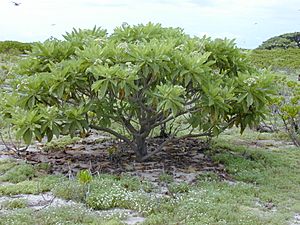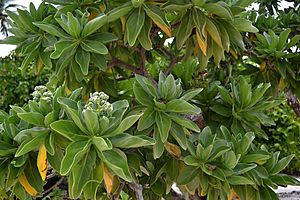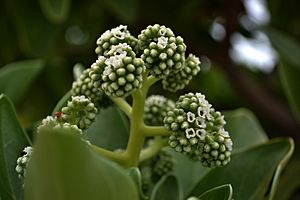Velvetleaf soldierbush facts for kids
Quick facts for kids Velvetleaf soldierbush |
|
|---|---|
 |
|
| In the Hawaiian Islands | |
| Conservation status | |
| Scientific classification | |
| Genus: |
Heliotropium
|
| Species: |
arboreum
|
| Synonyms | |
|
|
Heliotropium arboreum is a type of flowering plant that belongs to the borage family. It grows naturally in warm, tropical parts of the world. You can find it in places like southern China, Madagascar, and northern Australia. It also grows on many islands in Micronesia and Polynesia.
This plant has several common names. People call it velvetleaf soldierbush or tree heliotrope. Other names include veloutier and octopus bush. It is usually a shrub or a small tree. It often grows in areas near the coast, reaching about 3.6 meters (12 feet) tall. Its branches can spread out about 5 meters (16 feet) wide.
How Scientists Name Plants
Plants sometimes get new names as scientists learn more about them. This plant was first called Tournefortia argentea. Later, its name changed to Argusia argentea.
For a while, it went back to being called Tournefortia. Then, in 2003, scientists moved it to the genus Heliotropium and gave it its current name.
How People Use Octopus Bush
People have used Heliotropium arboreum for different purposes throughout history. For example, in the Maldives, the leaves were sometimes eaten. They were used as a source of food during difficult times.
Using the Wood
The wood from the octopus bush is useful for making many things. People often use it to create handicrafts and tools. In Polynesia, it is even used to make frames for swim goggles.
Because this wood is easy to find, it is also used as firewood. However, using it too much for burning has made the plant rare in some areas.
Medicinal Uses
On many Pacific islands, octopus bush is a traditional medicine. People use it to treat a sickness called ciguatera fish poisoning. This illness happens when people eat fish that have powerful toxins. These toxins come from tiny algae called Gambierdiscus.
Scientists are studying this plant to understand how it works. Researchers believe that older leaves of the plant contain special substances. These substances, like rosmarinic acid, are known to fight viruses and bacteria. They can also help reduce swelling and protect cells. Scientists think rosmarinic acid might help remove the fish toxins from the body. It may also help calm the body's reaction to the toxins.




